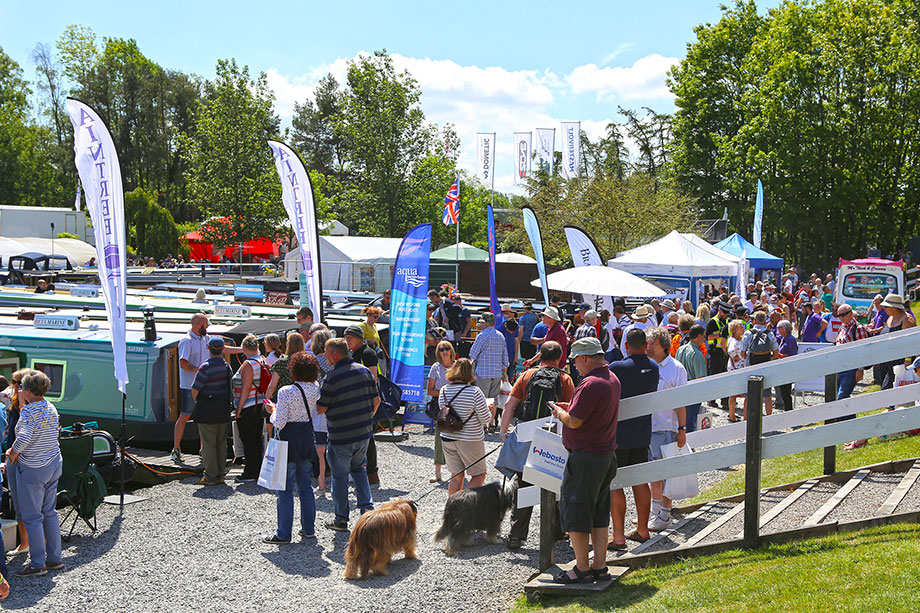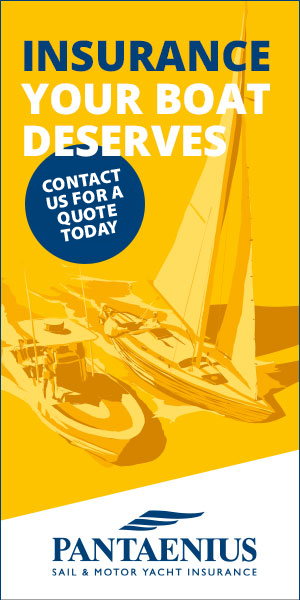Each year more than 250 canal boat industry exhibitors converge at Crick Marina for Britain’s biggest inland waterway event, the Crick Boat Show.
The event, which this year takes place across the Queen’s Platinum Jubilee Weekend, 3 – 5 June, is organised by Waterways World in association with the Canal & River Trust and Crick Marina. Over 26,000 visitors are expected to attend what has become the canal world’s biggest marketplace, showcasing new products and innovation in the sector.
Matthew Symonds, National Boating Manager for the Canal & River Trust, explains: “With environmental concerns increasingly on the minds of consumers, sustainability is a key area of innovation for the inland waterways sector.
“Each year, more boaters visit the Canal & River Trust Marquee at Crick Boat Show asking about ways to make boating more sustainable. Their concerns range from the damaging effect on wildlife of plastic pollution in our waterways, to electric engine charging points and waste disposal.
“Looking at our 2,000 mile network of inland waterways, The Trust is working with a range of partners and projects to support the Government’s decarbonisation agenda and tackle the physical effects of climate change. From water sourced heat pumps for heating and cooling canalside buildings and generating hydro-electric power on our rivers, to promoting active travel and the recovery of nature, there are many powerful ways our waterways can help the reduce carbon emissions and mitigate the effects of climate change.
“The Government’s Clean Maritime Plan states that by 2025 there must be a plan in place to ensure that all vessels, including those on the inland waters, are able to meet the zero emissions target by 2050.
“The Trust is committed to working towards a zero-carbon future for boating on our inland waterways, recognising that this needs to be a collaborative effort involving boaters, businesses, local authorities and the government.”
Free boating seminars at Crick Boat Show offer people advice on reducing their impact on the environment with green boating, and a series of bookable masterclasses with exhibitors providing updates on innovations such as low impact narrowboat hull designs, hybrid and electric engines, and the latest in battery technology.
From reducing waste afloat to the latest in engine technology, the Canal & River Trust has put together 15 sustainable boating tips and products showcased at this year’s Crick Boat Show.
1. Switch to electric or hybrid engines – electric boat engines are a vital component of our journey towards net zero in 2050, and for boats kept in marinas with electric charging points, fully electric engines are a great option. But while the electric charging infrastructure on our network is still in its infancy, one of the most efficient forms of propulsion is the Serial Hybrid system, which can reduce the fuel burned to one third of a standard diesel installation.
2. Fit a generator – boaters can massively reduce their carbon emissions by fitting a 240V generator to their boat engines, making the power they produce more versatile and useful. Using a diesel engine designed for motive power to heat the water on board is not an efficient use of energy. But using the engine to run a generator to power on board electrical systems is much more efficient.
3. Power sharing – one canal boat engine could be used to power the electrical systems of up to 30 boats, reducing costs and CO2 emissions. This only requires co-operation and simple equipment to distribute power from one engine to many boats.
4. Invest in Lithium batteries – replacing lead acid batteries with lithium batteries take less engine time to charge and they don’t need to be charged until full. Lithium batteries will do around 10 times more charges over their life cycle and they cost less to charge, particularly with careful charging management. So while their upfront costs might be higher than a lead acid battery, they save money and CO2 emissions over the longer term.
5. Choose HVO fuel – the Inland Waterways Association (IWA) has been trialling Hydrotreated Vegetable Oil (HVO) as fuel in a variety of boats. For the short to medium term, the IWA believes that HVO is a viable alternative to diesel, and one that most boaters can use immediately, reducing CO2 emissions by 90 per cent. The Canal & River Trust has been trialling HVO fuel on some of its workboats and has begun rolling out the use of HVO fuel for all its workboats.
6. Invest in solar panels – photovoltaic panels are increasingly efficient and boaters can choose from a wide range of solar panel products to heat their hot water systems and charge their batteries. Wind turbines can also help with battery charging.
7. Save water – by catching the first litre or so of water when going for a shower and use for rinsing in the kitchen, and by using washing up water to flush the loo.
8. Fit a water source heat pump – some canal boat builders are fitting water source heat pumps to their boats, transferring heat from the canal water to reduce other power consumption.
9. Use eco products on board – use eco products with lower phosphate type soaps for washing up on board and washing your boat, and make sure your toothpaste and shower gels are micro bead free. Avoid items with ‘polypropylene’ or ‘polyethylene’ on the ingredients list, and go for natural biodegradable alternatives. Use bees wax wraps instead of cling film and bamboo toothbrushes.
10. Choose water-based paints – using water-based epoxy paint systems reduces the time between painting coats and lowers the amount of hazardous chemicals introduced into the water system.
11. Reduce plastic waste – a staggering 80 per cent of marine debris comes from inland sources. Reduce plastic waste by using refillable water bottles, coffee cups and shopping bags. Also, make sure your rubbish is tied securely and put in canalside bins with closable lids. Waste put in the red Biffa bins along our waterways is sorted for recyclables, so please do use these bins or other recycling facilities along route.
12. Control those fenders – a frightening number of plastic fenders end up at the bottom of our locks. Consider changing to natural rope fenders and prevent your fenders adding to the plastic in the canal by making sure you don’t leave them dangling when cruising – except bow and stern fenders. When your fenders are in use, normally only whilst moored up, make sure they are properly secured.
13. #ActNowForCanals – join our #PlasticsChallenge by committing to pick up at least one piece of plastic litter each time you visit one of our canals, and take part in our ‘Spot that Habitat’ survey, showing us places where waterway wildlife would want to make a home.
14. Help us clean up – join of our Plastic Patrols or Towpath Taskforces, and help us clean up the litter that is dropped along our waterways. There are lots of events to choose across the country, some involving paddle boarding and canoeing if you are feeling adventurous. Find out more by visiting the Canal & River Trust Marquee at Crick Boat Show or go to www.canalrivertrust.org.uk
15. Become a Friend of the Trust – join us as a Friend from just £5 a month and help to support schemes like tree planting and other wildlife habitat enhancements, as well as fighting plastic pollution and protecting the future of our historic network of canals and rivers.
For more information and to book tickets, camping pitches and moorings, visit www.crickboatshow.com or call 01283 742970, Monday to Friday 9am to 3pm.
















